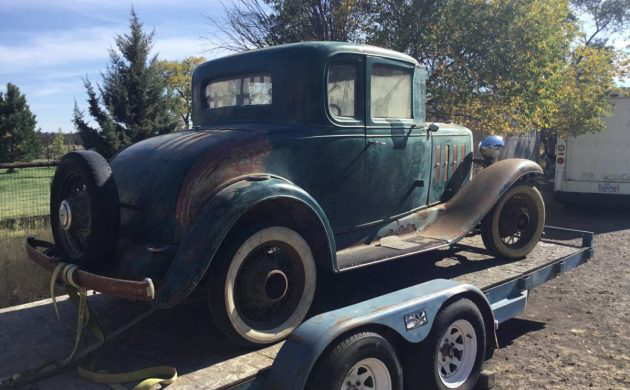When the year 1932 comes up in conversations between auto enthusiasts, the 1932 Ford looms large. It was the first year for the famous Flathead, and the year has always been the most popular for hot rod builders. Yet, even with an optional V-8 under the hood, Ford did not sit at the top of the sales charts that year. In 1932, Chevrolet sold 323,100 automobiles despite the economic hardships brought on by the Great Depression. This 1932 Chevrolet coupe for sale on Craigslist in Bend, Oregon is a dapper representative of the brand’s products for that year. Unfortunately, what appears to be poor storage has degraded this Chevrolet a bit, but the $12,000 asking price takes into account the car’s overall condition. What hasn’t been calculated is how much wood will need to be replaced behind those panels. Do you have the carpentry, bodywork, and mechanical skills to return this Chevrolet to showroom-new?
Why the concern about woodworking skills? Prewar Chevrolets of this vintage have a reputation for being built with a large amount of wood in the bodies for bracing. The way it worked for Chevrolet and just about every other make at the time was that the framework in the body was made of wood with panels attached to the outside. Much of this was due to the relatively limited nature of the presses that stamped out steel body parts at the time. Press technology had not developed to the point that large, complex panels could be mass-produced. Even a company like General Motors with all of its wealth was only able to stamp out panels not much larger than the ones seen on this car. It was more economical to attach those panels to a wooden structure than stamp out a large number of metal parts and weld them together.
This reliance on wood slowly faded away during the thirties as stamping technology improved. Chrysler’s Airflow was one of the first cars to use large amounts of steel in the framework of their bodies and the car was attacked in ads from General Motors for this. The argument was that steel wouldn’t provide the strength needed for the safety of the car’s inhabitants. Chrysler dropped a 1934 Airflow off of a 110-foot cliff and drove it away to prove that claim to be without merit. It wouldn’t be long before advances in stamping and the demands of the public would make the construction of an all-steel car body a reality.
Before that change, bodies like the one on this 1932 Chevrolet were assembled from many precisely cut pieces that all fit together well enough to protect passengers and provide a structure to attach the rest of the panels. Even the framework around the doors relied on wood. Over 90 years later, the wood on cars of this type is often found to be in rough condition. Shrinkage, insect damage, and the rot that occurs when the wood is not properly protected all work to cause issues with structural integrity. Looking carefully at the pictures of this Chevrolet reveals a car that has seen some water damage if the staining on the wooden bows to support the roof insert is any indication. There are signs of similar staining in the floorboards, and a chunk of plywood is covering up the floor directly behind this area.
While the car may have been exposed to the elements at one time, the seller tells us that it is a true barn find with virtually no rust and is free of body damage. It is also advertised as a complete, original car with no missing components. The pictures are evidence that the claims are legitimate, but this is not going to be a polish-up and drive “as-is” project. Luckily there is enough of the interior for an upholsterer to copy and the rest of the car has its rough spots but is restorable.
Under the hood is Chevrolet’s ubiquitous “Stovebolt Six.” The seller tells us that the engine “has not been tested.” If it is original to the car, the engine should displace 194 cubic inches and put out 60 horsepower. It was backed up with a three-speed transmission with synchronized gears and a freewheeling setup called “Wizard Control.” This allowed the car to coast when the driver lifted their foot off of the accelerator. Designed to save fuel, many cars of this era offered this feature. Freewheeling never caught on because you lost the effect engine compression had on slowing the car down. In an era where mechanical brakes were the norm and even the best systems would be considered inadequate by today’s standards, you needed all the help you could get.
In all, this is a restorable early thirties coupe that is complete and original. It is also much cheaper than a comparable Ford coupe from that year. While the V-8 and handsome styling have earned the Ford many more fans, the amount of wood in Chevrolets of this era has given them a reputation for being difficult to restore. Hopefully, the wood in this car is good enough to not require extensive work and it will be back to its former glory soon.









I would strip it down and replace the wood structure with steel or aluminium that I can cut and shape. Yes I know it would take away from the original but doing it that way it would last longer than me.
tons of work, I’ve done several, after adding up just your labor, not materials, your underwater.
Sadly the people who used to tackle these projects are growing few and far between. The price is about what a really nice one would bring. I did just sell a basket case 1931 Buick to a fellow though and I hope to see pics of it when it’s done.
Asking $12,000 for this car is a little cheeky. With all the work required for a restoration of it, and the final value after restoration being about $25,000, a more appropriate asking price would be around $4,000 to $5,000.
I believe that your estimate is pretty close.
Given the tendency of Chevrolet guys to stick small block Chevy’s in the Ford Model A coupes and call it a hot rod, this would be a perfect candidate to freshen up and install a Ford Flathead V8 in it the way the gods intended it to be.
I was just a month or two from my 15th birthday and I bought my first car. A 1932 Chevrolet 5 window Coupe, I paid $125 dollars for it and drove it home. I didn’t have a drivers licence, but my brother in law said you bought it, you drive it. I drove it out of my parents garage about a year later. It then had a SBC ,3 speed trans, 57 Chev rear end and Hydraulic brakes, from then on it was game on. Now at 81 and at least a 100 plus cars later the game is still on. I know it is in the late innings, unless it goes extra innings. So many cars and so little time
It would be nice with a tubular steel frame & a 350 Chevy/AT. I’d never chop the roof!
The first car I remember riding in was the family 32 chevy coupe, blue with black fenders. This was in the late 1940’s. It was supplemented with a 39 Chevy station wagon and when Dad bought his first new car, a 50 Ford Tudor sedan, the 32 got parked next to the garage for about a year. He paid a neighbor $15 to take it away around 1951. At that time, it was just an almost 20-year-old car, taking up space. I think the wagon got traded in on a 60 Renault Dauphine to be his daily driver on his 50-mile daily commute to save gas by not driving the 59 Ford on that 100-mile daily round trip.
This did stir up memories in my 80-year-old brain pan.
I agree with a previous estimate about this being a $4000-$5000 car. $12k for a non running non restored 1932 Chevy is beyond optimistic. Your underwater as soon as you pay that for it.
you got to love these time capsules not just the money
I’m just 77 years old but I still remember seeing a lot of these coupes and sedans puttering around the small Burgh I grew up in during the 1950’s. They were all different brands, Chevy, Ford, Mopar, Hudson, and every other make around. Some company made a box similar to a pickup bed you could install after removing the trunk lid. I borrowed $35 from one of my brothers to buy a 35 Chevy 4 door sedan in 1960. Down the road was a 32 Plymouth 4 door touring car parked for many years. It was the oldest car I had seen with a factory radio in the dash. Wood was a good form to build cars around in those days, I think ash was the most common. I hope this car gets fully restored putting aside costs just for the love history to be preserved.
God Bless America